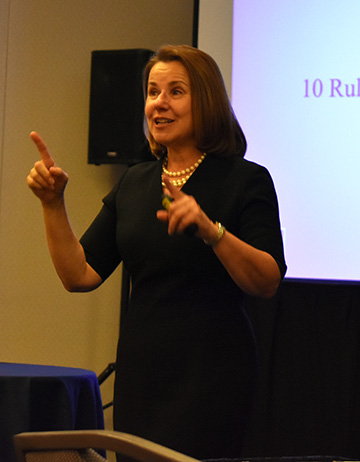
Learning how to navigate a business lunch and other social events can be a key to making connections and advancing professionally. [Image: Getty Images]
You’re a whiz with Maxwell’s equations, an emperor of photonic crystals, and have never encountered a metasurface that you couldn’t conquer. But now it seems you’ve met your match: a cocktail party at which you hope to meet and win over a future employer. What will you do?
The “soft skills” for negotiating business mixers, lunches and dinners are not the sort of thing one usually learns in graduate seminars—yet they often are the things that ultimately result in making the right contact or sealing a long-cherished deal. For scientists and engineers, who tend toward the introverted side, learning those skills is even more important. Fortunately, at the Frontiers in Optics/Laser Science 2018 meeting in Washington, D.C., the social-events coach Mary Crane was on hand to draw practical lines between social flair and faux pas.
From the White House to social-events advisor
Crane has undeniable street cred for the job. After a stint as a lawyer and lobbyist involved with nonprofits, she shucked off that world and headed up to Poughkeepsie, N.Y., to study at the Culinary Institute of America, after which she snagged a positon as an associate chef in the White House during Clinton Administration.
That position exposed her to a variety of highly gifted people who nonetheless seemed utterly flummoxed by how to handle a formal dinner or social occasion. Eventually, Crane decided to leave the White House to start her own operation helping such people learn the “rules of engagement” for navigating the social events that inevitably arise as one negotiates a professional career.
Take risks—armed with knowledge
In an energetic hour at FiO/LS, Crane exhorted an audience of bashful scientists to put themselves out there. “No matter what field you’re going into and where you want to go professionally,” she said, “the reality is that people need to know you and like you.” As a corollary, attending the social events that serve as glue in the business world is a necessity, not an option, even if it seems to offer only butterflies for the stomach.
“One thing I want to encourage you to do is to take risks,” Crane said. “It’s the only way to get ahead.” And, she added, it’s important not to give up—“Never hear a ‘no’ until someone actually says ‘no’.”

Mary Crane at FiO+LS 2018.
But taking risks doesn’t mean going in without a few arrows in your quiver. Crane has distilled her long experience into 10 rules for handling networking events. The rules include some surprising details. For example, rule #3, covering how to arrive at a networking event, not only dictates that you should arrive at the event on time, and immediately thank the host or hostess, but that your next step should be to walk to the bar, get a beverage, and hold it in your left hand.
Why? Because it gives your hands something to do—and it lets your right hand stay warm, dry and ready for your next handshake.
Selling your services
Crane’s other rules covered both an event’s big picture and its details: Who should be introduced to whom in an interaction (rule #2)*; where to put your nametag (rule #6)†; tips for how to “break and enter” into a conversation (rule #8).‡ Perhaps most important, however, was rule #1: Being rock-solid ready to introduce and describe yourself, with a name, a descriptor of who you are, and an interesting fact that will help you sell your services. Even in an audience of scientists, Crane maintained, “all of you are selling your services … each and every one of you wants to think of a way to help you become memorable. Think of it as your own 30-second commercial.”
Almost as important is the follow-up after the event (rule #10). First, take a look at the notes you made on the back of the business card you obtained from your new contact before leaving the event (that’s rule #9, by the way). Then, Crane said, you should draft a follow-up e-mail within 24 hours. The subject line should include the name of the event, and the message should ask for the opportunity to meet face to face.
“If it’s a professional message,” according to Crane, “it should start with ‘Dear’ and end with ‘Sincerely’.” And you should be sure to write “I enjoyed meeting you” and mention something concrete that you discussed when you met.
The business meal
In a few minutes at the end of the session, Crane swung through a similar set of rules for navigating the treacherous waters of a business meal. Among her injunctions: Don’t order the most expensive item on the menu; don’t order something you “don’t know how to eat”; and avoid “danger” foods such as wings, shellfish, cheesy French onion soup, juicy hamburgers, and other fare whose eating might draw unwelcome attention to itself.
Also important is not to start eating until everyone is served, and to avoid eating too fast or too slow. “If you’re always the first one to finish,” said Crane, “you’re not talking enough.”
Finally, Crane recommended that, whether it’s lunch, dinner or something else, never forget that it’s a business event—and act accordingly. Don’t consume alcohol (or, at least, know your limits). And “never, ever act rudely toward wait staff,” Crane stressed—pointing out that for some employers, seeing how a potential employee treats the staff is one of the main reasons for taking them to lunch in the first place.
(Crane’s appearance at FiO+LS 2018 was sponsored by the OSA Foundation.)
*Do a split-second assessment of “who’s most important,” says Crane—and then ask the more important person if you might introduce them to the less important.
†On your right-hand lapel—so that it’s in the other party’s view when you shake hands.
‡Don’t break in on one-on-one conversations. But if you see three or more people in a group, linger on the edges, and then step into the conversation as soon as two have spoken. Crane’s advice: “Get used to breaking and entering” in this way.
